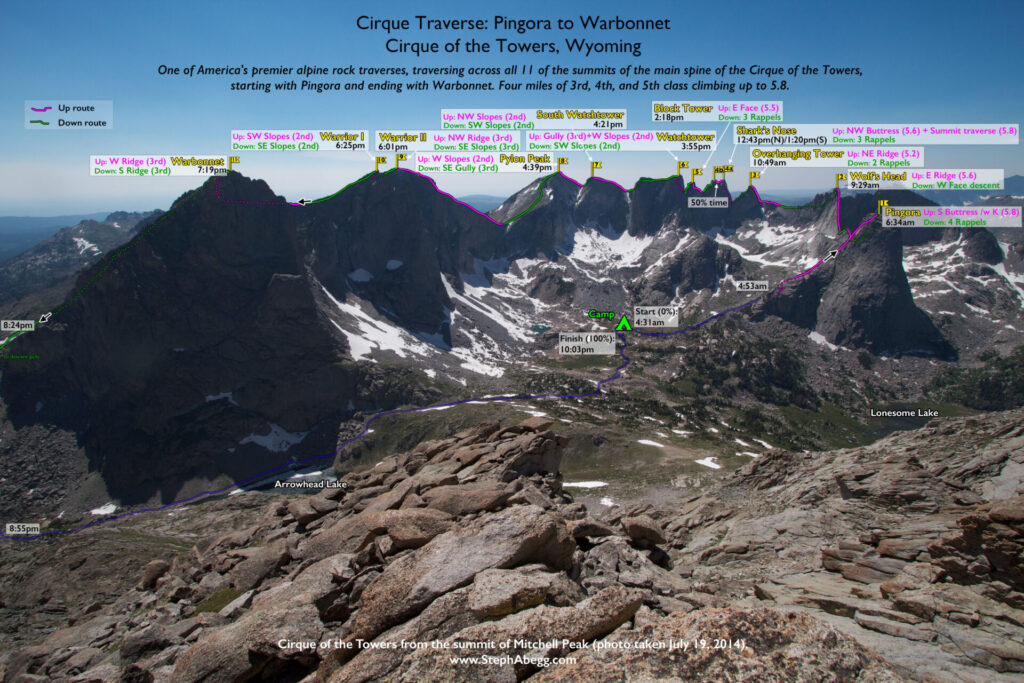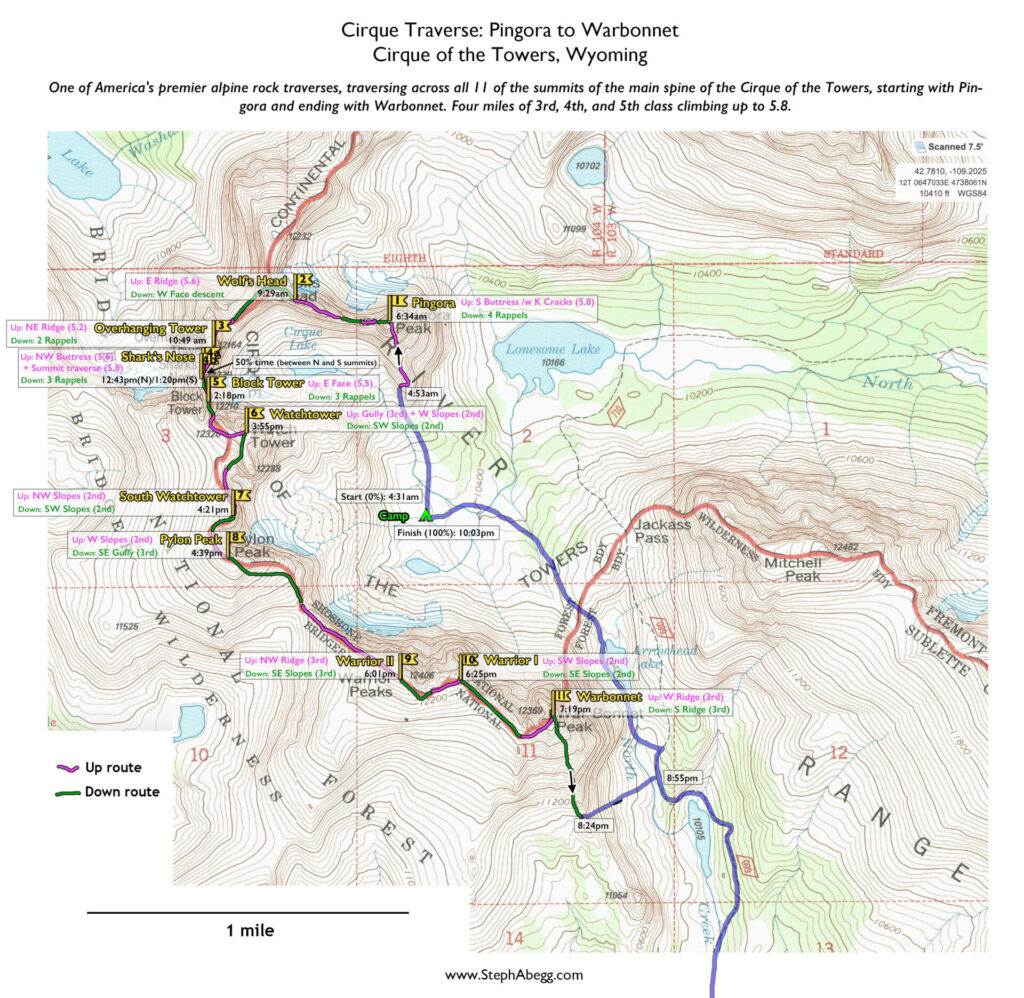The Plan
If you're familiar with my website, you will know that I am a fan of traverse routes involving multiple summits. Some of my favorite traverses I've done to date are: in Washington: the
Complete North to South Pickets Traverse, the
Ptarmigan Traverse, the
Torment-Forbidden Traverse, and the
Olympics Range traverse; in British Columbia: the
Sir Donald Traverse and the
Viennese-Clarke Traverse; in California: the
Cathedral Traverse, the
Palisade Traverse (somewhat incomplete, I need to go back to this one), and the
Evolution Traverse. One traverse I'd wanted to do for years was the Cirque Traverse, which traverses across all 11 of the summits of the main spine of the Cirque of the Towers in Wyoming, starting with Pingora and ending with Warbonnet, entailing four miles of 3rd, 4th, and 5th class climbing up to 5.8. The Cirque Traverse in one of America's premier alpine rock traverses (and now having done it I'd fully agree with this statement - the whole thing felt like an engaging awesome mountain obstacle course).
I knew the perfect partner for the adventure: Casey Andrews, who I had done the Evolution Traverse with in July 2017. Both Casey and I are athletes, love long days in the mountains, and share a pet peeve of stopping for breaks or wasting time, so we make a great team for an athletic Traverse like this. Casey was of course interested and fortunately he had a rare window of time long enough to justify the drive from his home in California. So we made plans to do the Cirque Traverse in late July.
Our plan:
- Day 1: Hike ~10 miles into the Cirque and establish a basecamp.
- Day 2: Leave camp an hour before sunrise (4:30 am). Do Cirque Traverse. Arrive back at camp hopefully the same day. (We arrived back at camp at 10pm, 17.5 hours after we left.)
- Day 3: Either hike out or climb something else. (A mixed weather forecast for this day and tired bodies encouraged us to hike out, satisfied with our successful 11-summit day the previous day!)
Our rack and rope, where we roped up, where we rappelled
The climbing on the traverse is a mix of 3rd, 4th and 5th class up to 5.8. We brought a single rack (cams from tips to #3), a set of nuts, a dozen shoulder slings, and 3 double length slings. For a rope, we had a light 70m rope (we would have brought a 60m rope, but my 70m was lighter than Casey's 60m option).
We soloed most of the route. We roped up for the following three sections of fifth-class climbing. On these roped sections, we often simuclimbed to speed things up.
- Pingora: South Ridge /w K-Cracks variation (5.8)
- Wolf's Head: East Ridge (5.6)
- Shark's Nose: The Thoroughfare (5.6) and the Summit Traverse (5.8)
We rappelled 17 times, several of the raps being about 30m (so bring at least a 60m rope). Some of the terrain that we rappelled was downclimbable, so we usually made the decision of whether to rappel or downclimb based on if we already had the rope out or the consequences of a fall. Some of the terrain was not downclimbable, so you definitely want a full rope for the Traverse. We got our rope stuck only once, on Overhanging Tower (fortunately the terrain was mid-5th so we were able to solo up and down to free it quickly). We rappelled at the following locations:
- Getting off Pingora (4 raps - mid 5th terrain)
- Getting off Tiger Tower (2 short raps - mid 5th terrain)
- Getting off Wolf's Head (3 raps - mid 5th terrain)
- Getting off Overhanging Tower (2 raps - mid 5th terrain)
- Getting off Shark's Nose (3 raps - very vertical terrain - not downclimbable)
- Getting off Block Tower (3 raps - very vertical terrain - not downclimbable)
Footwear
We wore approach shoes for all of the 3rd and 4th class sections of the traverse as well as the rappels. I put on climbing shoes for all of the 5th class sections, while Casey remained in his approach shoes for some of the easier 5th class.
Water on the route
There were snowpatches at some of the cols, but no running water until we got to the east slopes of Pylon Peak. This was was from snowmelt which would not be present in later summer.
The weather
We had perfect weather for this adventure. The morning was cloudless and low stress. It was an unusually warm and calm day, with just a slight breeze. The first afternoon clouds started to dot the sky around 1:30pm, when we were on Shark's Nose, past the halfway point on the route and done with the hardest climbing. The clouds provided a bit of relief from the sun. The clouds thickened over the next couple of hours, but nothing threatened. When we popped up on the shoulder of Warbonnet at 3:30pm, there were some small storm systems on the horizon, but nothing nearby. After this point, the terrain is no more than 3rd class (i.e. weather could move in and you could still keep going), and we knew we had the traverse in the bag. One of the small storm systems moved over us just as we reached the trail around 9pm, reminding us to be thankful for the weather window we had been given. I would not suggest doing this Traverse unless you are pretty confident in the forecast to be dry until you at least reach Warbonnet. There is a lot of scrambling on steep terrain that would be rather dangerous when wet. Plus, it's way more fun in good weather.
Route-finding
Before embarking on the Traverse, we wrapped our heads around the Traverse and the route we would take up each peak and the means of descent. It also helped that I had climbed the first four summits already and made the descent from Warbonnet. So we had no major route-finding issues, apart for climbing to the false summit of Warbonnet only to realize Warbonnet was the next one over (we simply continued over to the true summit, but lost a bit of time since we had dropped our packs in an inefficient spot before heading up to Warbonnet).
Camp-to-camp time
Our camp-to-camp time was 17.5 hours. I feel like this is a pretty respectable time for a competent, athletic party moving at a comfortable pace. We didn't stop much and we were quite efficient, we simulclimbed and even soloed the 5th class to save time, and we made no significant route-finding errors. Part of what took up time was getting the rope out and then get it re-packed—we probably spent more rope time rappelling than we did doing roped-up climbing. We were also never rushing or breathing all that hard. Perhaps we could have shaved a couple of hours off this time if we were really going for a speedy time, but this would have made it less enjoyable. As it was, it was just an enjoyable athletic romp in the mountains. A sub-24 hour car-to-car time is a completely reasonable target (shave an hour off the camp-to-camp time, and then do the approach with light packs and with intent towards speed). As a related note, our 50% time occurred on Shark's Nose during the traverse from the North summit to the South summit; interestingly, this was the crux pitch of the route.
Photos, Overlays, and More!
The following page gives a trip report for our traverse, including maps, stats, and lots of photos. What an awesome adventure involving 11 summits in one day!

























































































































